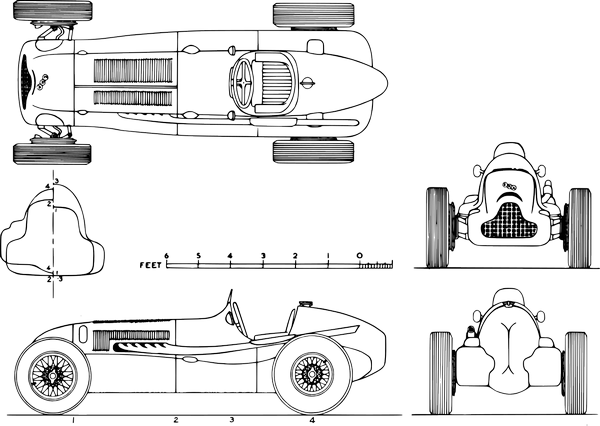Miniature Autoworld March 1965 | Drawn and described by Malcolm T. Firth
ERA Type B
AFTER Raymond Mays and Peter Berthon had raced a modified 6 cylinder Riley in the 1933 season with much success, they were approached by Humphrey Cook with the suggestion of forming a company to build racing cars. The new firm of English Racing Automobiles was formed with premises in the grounds of Mays' own home in Bourne, Lincolnshire, the same buildings now being the present day B.R.M. headquarters.
With the aid of Reid Railton on chassis design, and T. Murray-Jamieson on superchargers, the first E.R.A. appeared in the spring of 1934. Four examples of this first A type E.R.A. were built, principally to partake in sprint and hill climbs as well as Voiturette races, and engine sizes of 1100c.c., 1500c.c. and 2 litres were produced. In each case the engine was a 6-cylinder derived from a Riley design and blown with a Murray-Jamieson designed Roots type supercharger.
In 1935 the 1½ litre version was built for sale to private entrants, differing slightly from the earlier A type. These B types had softer rear springs and additional chassis bracing under the rear seat, and the first of these, chassis No. R.I.B., was sold to Dick Seaman who competed with this car in British and Continental events until he joined the famous pre-war Mercedes team, and it is this B type car which is depicted in the plan as it is raced today.
The B type 1½ litre engine was, as previously mentioned, derived from the Riley 6 cylinder engine with a very sturdy cylinder block in which the crankcase extends far below the crankshaft centre line. The three bearing crankshaft is very heavily counterweighted and although of very long stroke the engine revs easily up to 7500 r.p.m. The fuel mixture is fed to the engine from a single S.U. carburettor through a two lobe Roots type super charger bolted on the nose of the engine. The hemispherical cylinder head has two valves per cylinder operated by short push rods and rockers from twin camshafts mounted high in the crankcase as on the Riley design. The drive is taken direct to a Wilson preselector gear box mounted in unit with the engine, giving road speeds of 125, 98.70 and 42 m.p.h. in the gears.
Drive is taken from this by a torque tube propeller shaft to the rigid back axle. The rear suspension has short half elliptic springs shackled at both ends to outriggers from the frame. The front suspension has a rigid beam front axle mounted against on short semi elliptic springs.
The main chassis frame is of channel side members with scanty cross members, being very prone to flexing. The B type had Girling mechanical brakes but many of these were converted privately to a Lockheed hydraulic system before the war. The friction type shock absorbers originally fitted were also often discarded in preference to hydraulic piston dampers.
Being primarily designed for sprint and hill climb work, not much attempt was made to produce wind cheating bodywork, and although the car is very slim, the high central driving position does not help in this respect although it does give a first class view of the road.







